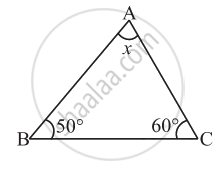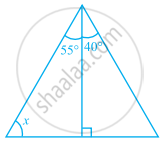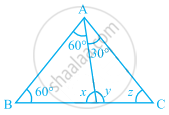Advertisements
Advertisements
प्रश्न
The angles of a triangle are arranged in descending order of their magnitudes. If the difference between two consecutive angles is 10°, find the three angles.
उत्तर
Let one of the angles of a triangle be x. If angles are arranged in descending order. Then, angles will be x, (x – 10°) and (x – 20°).
We know that the sum of all angles in a triangle is equal to 180°
So, x + (x – 10°) + (x – 20°) = 180°
⇒ x + x + x – 30° = 180°
⇒ 3x = 180° + 30°
⇒ 3x = 210°
⇒ x = `210^circ/3` = 70°
Hence, angles will be 70°, 70° – 10° and 70° – 20° i.e., 70°, 60° and 50°.
APPEARS IN
संबंधित प्रश्न
Find the value of the unknown x in the following diagram:

Find the value of the unknown x in the following diagram:

In ∆RST, ∠S is 10° greater than ∠R and ∠T is 5° less than ∠S, find the three angles of the triangle
If ∆MNO ≅ ∆DEF, ∠M = 60° and ∠E = 45° then find the value of ∠O
How many triangles can be drawn having its angles as 53°, 64° and 63°? Give reason for your answer.
Two adjacent angles are equal. Is it necessary that each of these angles will be a right angle? Justify your answer.
In ∆ABC, ∠Α = 100°, AD bisects ∠A and AD ⊥ BC. Then, ∠B is equal to ______.
It is possible to have a triangle in which each angle is greater than 60°.
In the given figure, find the value of x.

In the given figure, find the values of x, y and z.

